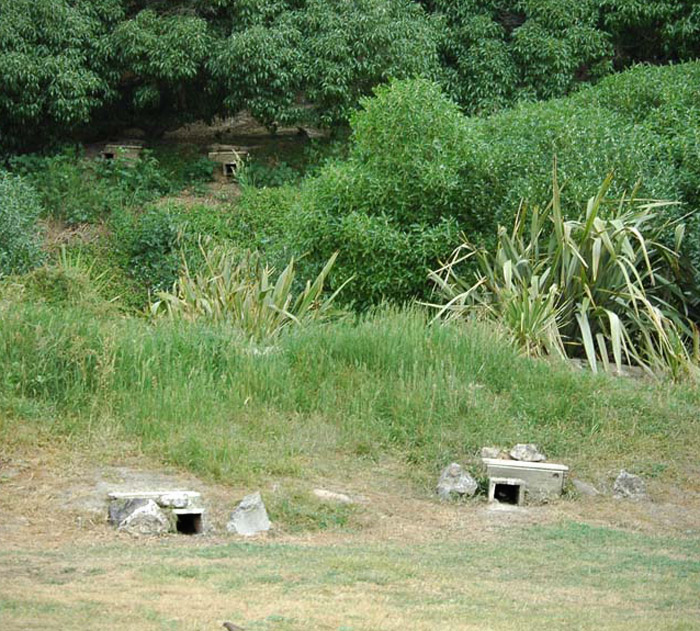Hole in the Clouds
Sep 4, 2009
Joe Stein is admiring dinner. It should be tasty, thanks to Joe's buddy Joe Fair, who went catfishing the other night in the Black Warrior River near Moundville, Alabama.. According to one of the Joes, it took an hour to reel in the big guy.
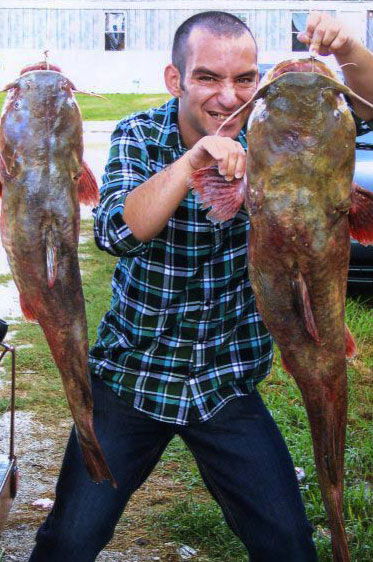
Alabama
animal
food
fish
Joe Stein
Joe Fair
(Image credit: Joe Fair)
Aug 21, 2009
Ever since last week, the Susquehanna River's been missing a big fish. Just kidding--he threw it back. Allen says this small-mouth bass is 19 inches long and weighs about four and a half pounds.
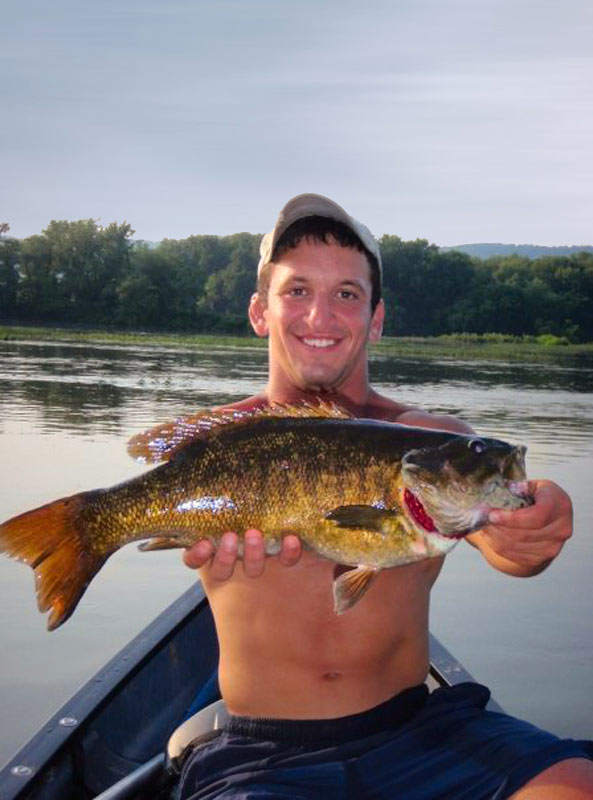
animal
fish
Allen Stein
Susquehanna River
Pennsylvania
(Image credit: Mike Landis)
May 7, 2011
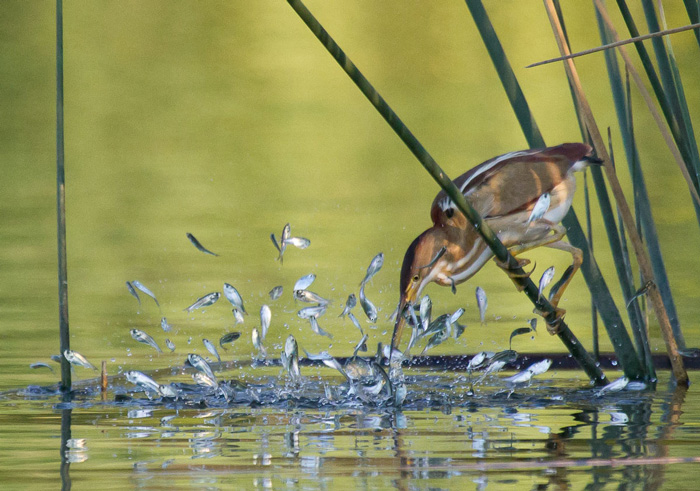 Not all of these menhaden are going to escape from the big bird–but then again, some of them will live to swim another day. Or if not another day, maybe at least till lunchtime?
Not all of these menhaden are going to escape from the big bird–but then again, some of them will live to swim another day. Or if not another day, maybe at least till lunchtime?
The bird is a female least bittern, and she was fishing last week in Horsepen Bayou, near Pasadena, Texas.
Texas
fish
landscape
animals
bird
Horsepen Bayou
wildlife
(Image credit: Gary Seloff)
Dec 6, 2012
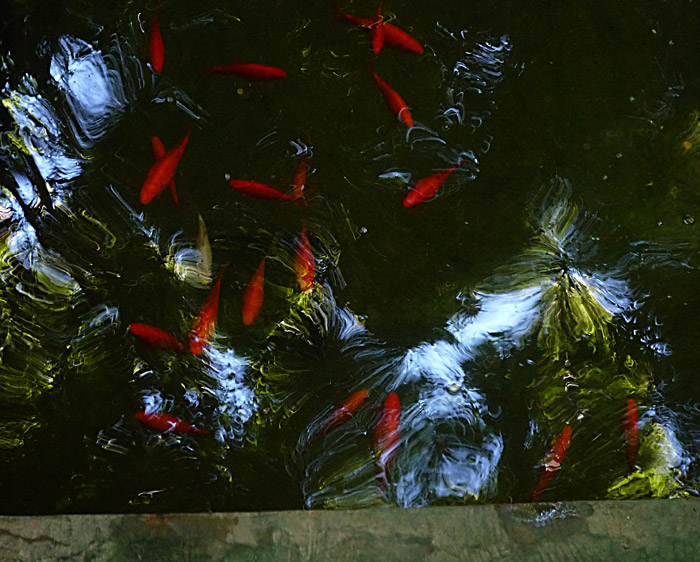 Fish swim amongst rippling reflections in Yves Saint-Laurent's Moroccan oasis, the Majorelle Gardens in Marrakesh.
Fish swim amongst rippling reflections in Yves Saint-Laurent's Moroccan oasis, the Majorelle Gardens in Marrakesh.
French painter Jacques Majorelle designed the gardens in 1924 as a botanical conservatory for desert plants and a celebration of Moroccan style and color. But ever since the 1950s, when Majorelle suffered serious injuries in a car accident and returned to France, the gardens languished unattended. Saint-Laurent, who had a vacation home in Marrakesh, bought the place in 1980 and worked for years to restore it. Per his directive, his ashes were scattered here following his death in 2008.
fish
garden
pond
Yves Saint-Laurent
pool
Morocco
Jaques Majorelle
Marrakesh
(Image credit: K. Maldre)
Jul 9, 2013
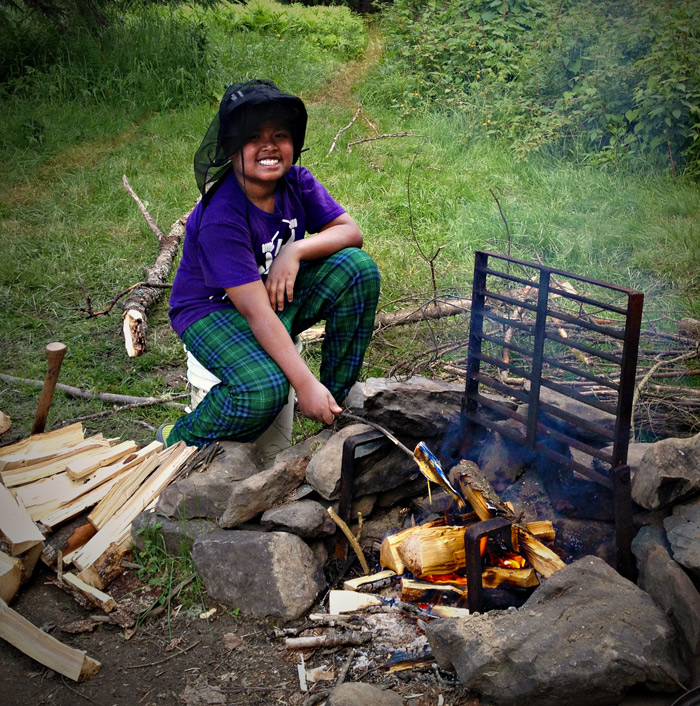 The story is that Sam here, a Boy Scout with Troop 97 in Portland, Maine, caught a heck of a lot of fish last week when his troop paddled the Allagash River up in northern Maine. He released most of them back to the wild, but this little trout had dinner written all over him.
The story is that Sam here, a Boy Scout with Troop 97 in Portland, Maine, caught a heck of a lot of fish last week when his troop paddled the Allagash River up in northern Maine. He released most of them back to the wild, but this little trout had dinner written all over him.
fish
Maine
Boy Scouts
Allagash River
canoeing
(Image credit: Susan Wiggin)
Dec 23, 2013

They eat guppies in New Zealand.
Actually, I don't know if they eat guppies there, but they definitely eat wormy little baby fish they call whitebait, which are similar to guppies in size, sliminess, and bug-eyedness.
Every spring, wherever rivers run into the sea in New Zealand, which is pretty much everywhere, people go whitebaiting. They rig up fine mesh nets from docks called whitebait stands or they pull up a chair along the riverbank or swing nets just inside the surfline at the river mouth. When the fish start running, the whitebaiters cook up their catch, usually as fritters made with egg and a bit of flour, often served on buttered bread.
The fish known as whitebait, which actually include at least five different species, are born in freshwater, get swept out to sea as babies, then return as juveniles to run upriver, where they will mature and spawn . . . if they don't get netted along the way.
Despite strict government regulation, the whitebait runs nowadays aren't what they used to be. A hundred years ago, whitebaiters caught more than they could ever hope to eat; they fed the excess to pigs or buried it in their gardens as fertilizer. In recent years, however, agricultural chemicals and population pressures in river valleys have destroyed much upriver whitebait habitat. Also, there's the obvious unsustainability of catching so many baby fish before they have a chance to grow up and reproduce.
Only in the nearly roadless region of South West New Zealand, where rivers plunge through rainforest from alpine heights to the coast, has whitebaiting remained as productive as ever. Whitebait buyers on the rivers there acquire the makings of fritters for stores and restaurants all over the country.
They're not cheap. In 2006, fresh whitebait went for $12.95 per hundred grams–about $60 a pound.
fish
New Zealand
coast
rivers
sustainability
whitebait
South West
(Image credits, from top: Juliette Armstrong, Rick Wilmore, Little Fuji)
May 3, 2014
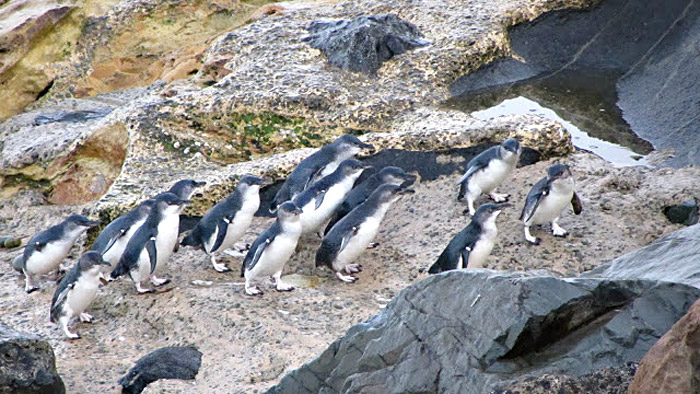 About forty years ago, the limestone in the old quarry down by the waterfront in Oamaru was finally all worked out. The quarrymen left, taking their big machines with them.
About forty years ago, the limestone in the old quarry down by the waterfront in Oamaru was finally all worked out. The quarrymen left, taking their big machines with them.
The penguins moved in.
Penguins are common in seaside places all over New Zealand, and the Little Blue penguins like the ones in the Oamaru quarry are the commonest of all. New Zealanders generally seem to be fond of penguins and often place nestboxes in their yards to attract them. But city officials in Oamaru felt the town quarry was a terrible spot for a large penguin colony; for one thing, the birds were going to cause all kinds of traffic problems when they went waddling across the roads. For another thing, the quarrying operation had utilized some nasty chemicals, the residue of which might potentially sicken penguins. And then also, of course, somebody might want the real estate to feather his or her own nest, so to speak....
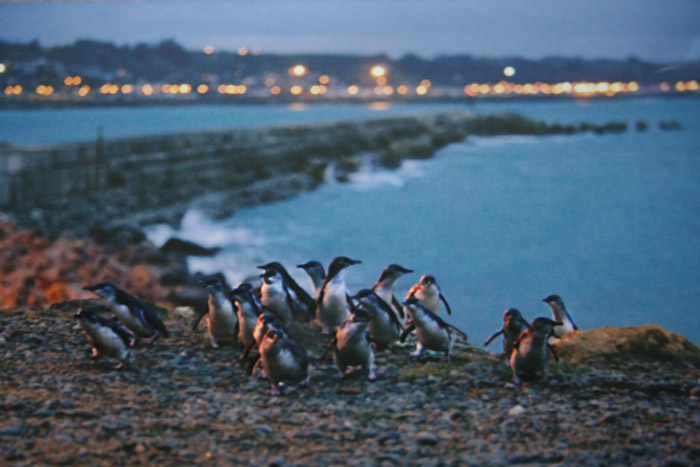
So the birds were moved out, to a site down the coast considered more appropriate. But they came back. Their nests were destroyed, and nice new nestboxes were offered them at the alternative site. They still went back to the quarry. Little Blues do that. They are the smallest of all penguins, not even knee-high, and they are homebodies.
Unlike many species of birds, including several penguin species, Little Blues do not migrate. They settle in communities of hundreds or even thousands of birds, often building their nests within a few feet of the spots where they themselves hatched and were raised.
Every morning, they gather in groups--called rafts--of a dozen or so birds that head down to the beach together and then out into the surf; they swim together for miles to their fishing grounds, where they spread out to spend the day alone, diving a few feet down to catch their favorite fish, a small, shallow-schooling variety called slender sprat.
Penguins have hooks on their beaks and barbs on their tongues, ideal for grabbing onto slippery fishy things.
Every evening, the penguin rafts reassemble and swim back to their home beach, where the birds emerge from the sea and climb back up the bluffs to their nests.
In 1992, the city of Oamaru finally gave up on its penguin-relocation project, perhaps because people had figured out how to monetize the colony. They fenced off the old quarry, opened a gift shop, sold tickets, even built a grandstand so visitors could sit comfortably while they watched the evening parade of feathered finery.
The organization that manages the Oamaru penguin colony also sponsors scientific research into penguin-human interactions. They report that the colony has continued to grow and thrive despite the thousands of tourists tromping through. Breeding pairs currently number about 160, laying between 250 and 500 eggs each spring, of which about 80% will hatch; about 80% of the hatchlings survive to fledge, when they can go out fishing on their own.
The quarry has been cleaned of old industrial waste and outfitted with nestboxes, some of which are designed so that researchers can watch the goings-on inside. And every evening, beginning around sunset, while tour guides keeps the tourists apprised of what the birds are up to, staff members carefully count the number of Little Blues coming back from the sea.
fish
New Zealand
Pacific Ocean
limestone
penguins
Oamaru
quarry
nest boxes
Apr 16, 2015
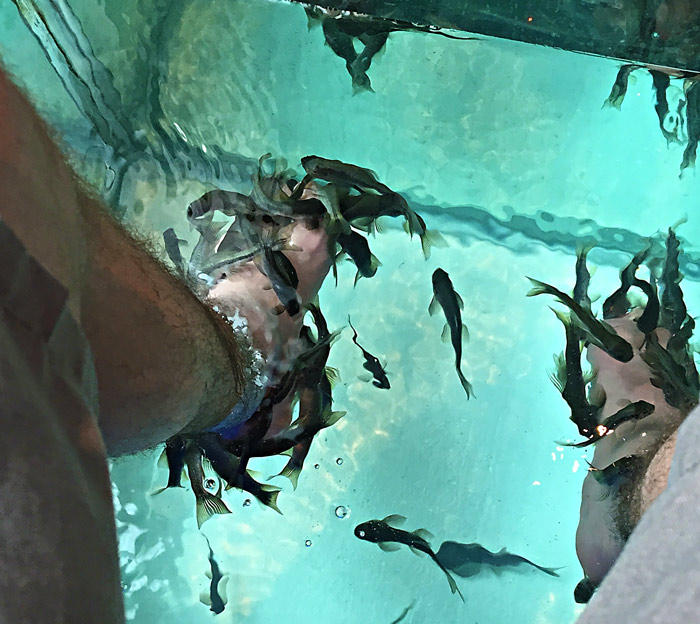 For this fishy selfie, Al went to a fish spa in Singapore, where he soaked his feet in a tankful of Garra rufa, a species of toothless fish native to the Middle East that have long been used for medical and cosmetological purposes.
For this fishy selfie, Al went to a fish spa in Singapore, where he soaked his feet in a tankful of Garra rufa, a species of toothless fish native to the Middle East that have long been used for medical and cosmetological purposes.
Garra rufa, sometimes called doctor fish, nibble away at dead skin to exfoliate people's feet. The nibbling is said to offer some temporary relief to people with certain skin conditions, including psoriasis. But mostly, people let the fish nibble on them as part of a pedicure, removing dry patches of dead cells and exposing fresh, new skin.
Al spent a week in Singapore recently as part of his work protecting the brick and mortar that surrounds the digital cloud. By coincidence, his New Zealand Aunt A. was in Singapore at the same time, and the two of them went together to get their feet nibbled.
fish
Singapore
selfie
spa
Garra rufa
pedicure
(Image credit: Allen Stein)
May 31, 2016
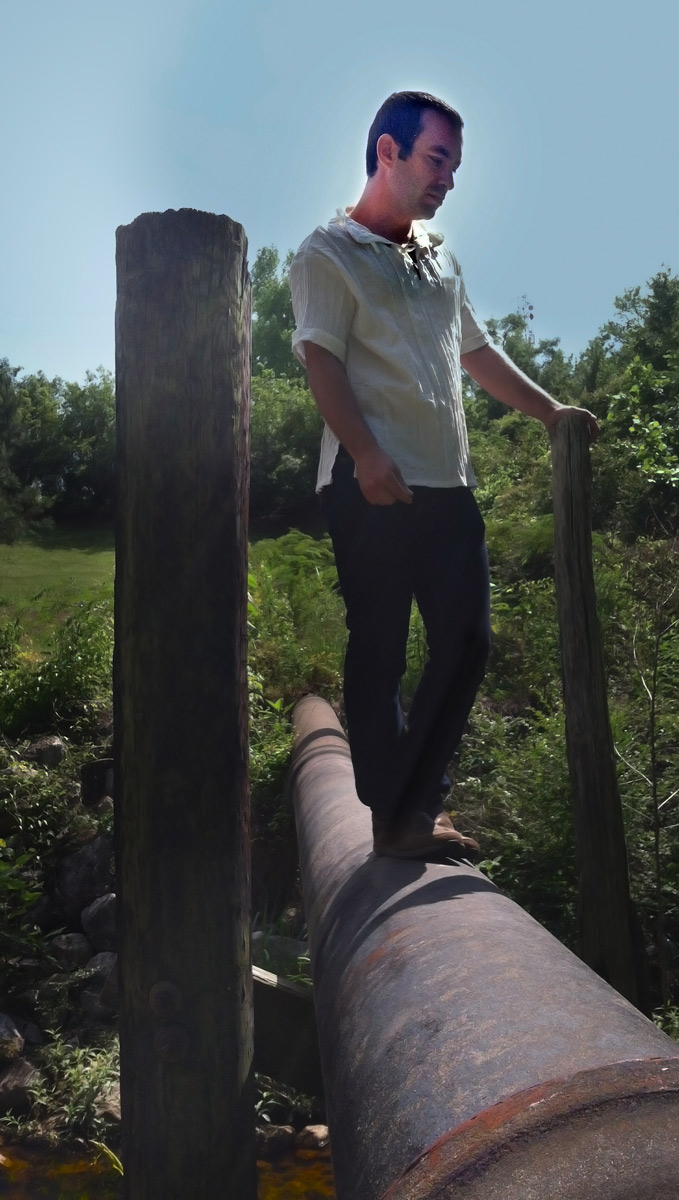
When Joe got back to Tuscaloosa this month after his semester in Cuba, he had fish to check up on.
He's a fisherman and also sort of a fish collector; for the past year or so, he'd been raising baby fish from the Black Warrior River, the little bream and other small fry that would normally be thrown back into the river. Joe kept dozens of them in a large aquarium in his living room, and dozens more in a pool in a tiny creek that runs into the Black Warrior near downtown Tuscaloosa. He named them and fed them and got kind of attached to them.
But when he left for Cuba in January, he moved all his fish to the little creek and wished them well. They were on their own.
Happily, they survived the winter, though heavy rains apparently washed them downstream into a different pool. In this picture, Joe was walking along a drainpipe that criss-crossed his creek, trying to see how his babies were doing. They were growing and swimming actively and doing all the right fishy sorts of things.
Joe now is living in Philadelphia, where he has a bowl of goldfish. He's completed all his coursework and will graduate in August from the University of Alabama.
Tuscaloosa
fish
Joe Stein
creek
fishing
Black Warrior River
bream
Feb 19, 2017
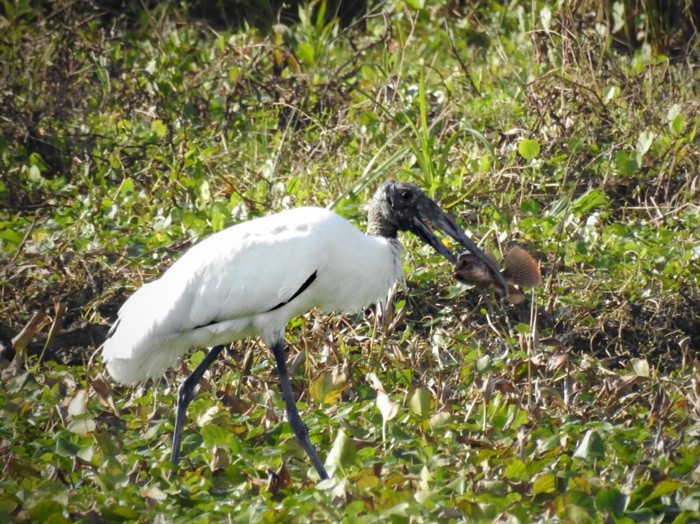 A wood stork grabs brunch in a marsh near Tampa, Florida.
A wood stork grabs brunch in a marsh near Tampa, Florida.
February is breeding season for America's only native stork species; it is also dry season in the storks' Florida habitat, which means that ponds have become shallower and smaller, concentrating the fish population for easy pickings when these long-legged fish-eaters go out wading.
For what it's worth, wood storks are bald-headed, like certain other all-American birds, e.g., turkeys and vultures.
fish
Florida
pond
marshland
wood stork
(Image credit: Betty Cracker, via Balloon-Juice.com)





 They eat guppies in New Zealand.
They eat guppies in New Zealand.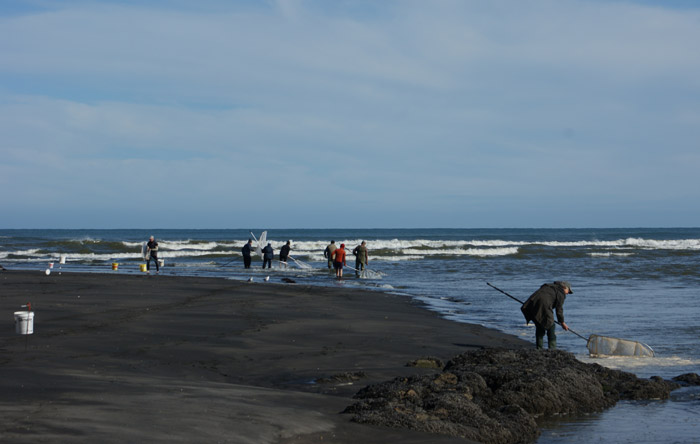
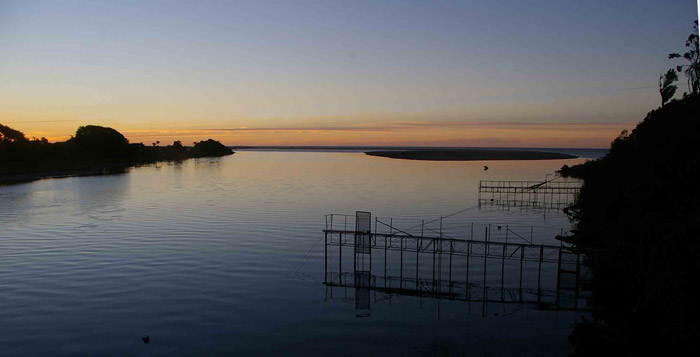
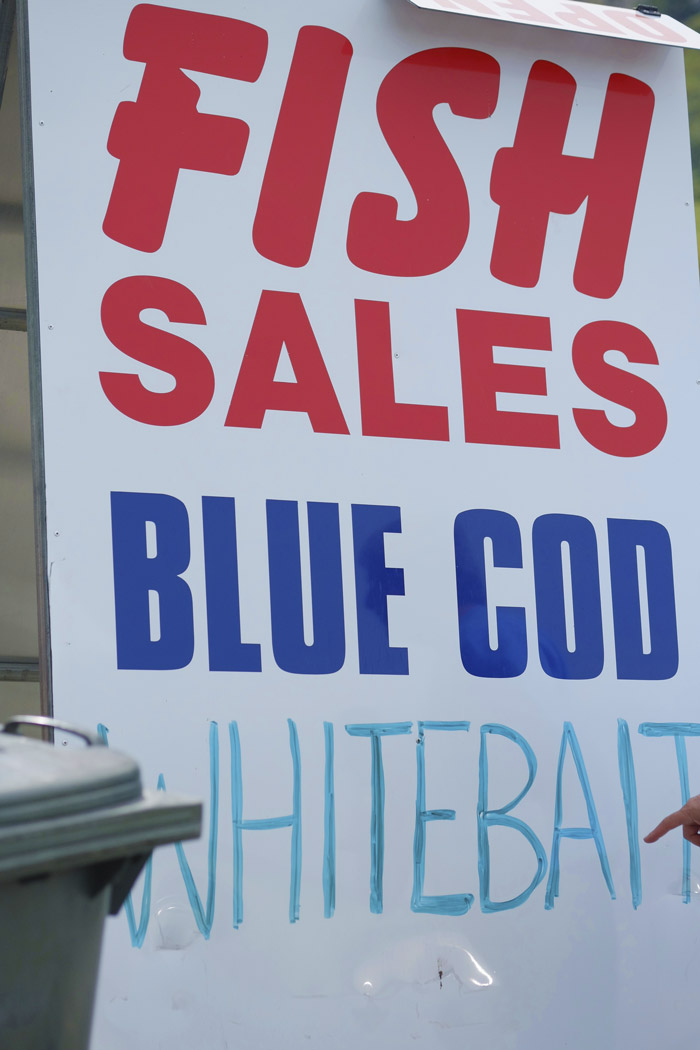
 About forty years ago, the limestone in the old quarry down by the waterfront in Oamaru was finally all worked out. The quarrymen left, taking their big machines with them.
About forty years ago, the limestone in the old quarry down by the waterfront in Oamaru was finally all worked out. The quarrymen left, taking their big machines with them.
